Development of Kirby's Dream Land
The development of Kirby's Dream Land began in May 1990, was largely complete the following year, and essentially concluded by the spring of 1992 when the game released in Japan. The game's creation took place against a highly turbulent background of financial turmoil and management conflicts at HAL Laboratory, leading to direct intervention from Nintendo to maximize the chances of the game's success on the market.
1990: the "Popopo" proposal[edit]
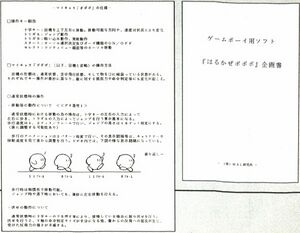
In 1989, Masahiro Sakurai joined HAL Laboratory as a game designer, still in his teens at age 19 and fresh out of high school.[1][2] Just at the start of his career, he had begun to confront the difference between a "work" and a "product", the gap in expectations between creators and marketers.[2] At the same time, HAL Laboratory was looking for designs for "a game that anyone could enjoy",[3] and Sakurai wrote and pitched a proposal for a Game Boy game in May of 1990, still aged 19.[4][5]
The driving idea behind the proposal was an action game that made use of enemies.[6] The player character would be able to inhale enemies and spit out the mouthful to attack, although Sakurai had initially considered having the character use tongue grabs to capture foes (resembling one of Yoshi's defining moves, although Sakurai wrote the proposal before Super Mario World had released).[4] Sakurai also designed the proposal with two other key aspects in mind, meant to attract a wide audience.
- Sakurai recalled "want[ing] to make a cute main character who everyone will love".[3] This influenced the design of the game's protagonist, who was pink from the very start (apart from one time when an orange marker was used by mistake).[3][7]
- Sakurai also aimed to make the game accessible and fun to beginners in particular.[5] Contemporary home video games were notorious for their difficulty, with retrospectively proposed reasons ranging from a need to extend play time within the constraints of a game cartridge ROM,[4] to an unintentional result of game programmers simply becoming abnormally good at video games through repeated play testing.[8] Sakurai's proposal was the very antithesis of such games: on top of being able to inhale and spit out enemies, the design allowed players to fly freely over the terrain, thus offsetting the harshness of losing a life for falling through a gap in the stage.[4]
An aspect of the proposal that wound up being discarded was an "off-screen death" mechanic, knocking the player character across the screen by a distance inversely scaling with remaining health, up to the most extreme case of being knocked entirely off-screen and losing a life. Sakurai, by his own later admission, would forget entirely about this idea until reinventing it for the Super Smash Bros. games.[5]
Sakurai titled this proposal はるかぜポポポ (Harukaze Popopo), literally translating to "Spring Breeze Popopo" or less literally to "Popopo of the Spring Breeze", and named his game's character "Popopo".[9] The proposal states that the setting has a "light, pop art, simple design with an emphasis on familiarity and ease of entry", provides a basic plot summary that remained mostly unchanged in the final product, and lists five stages: "GREEN GREENS", "FLOAT ISLANDS", "FIRE DESERTS", "BUBBLY CLOUDS", and "MT. DEDEDE". It also set a release date for summer of 1991.[10] As Sakurai was already working on other projects, development on the game started at a later date,[4] and overall took under a year.[5]
1991: "Twinkle☆Popo"[edit]
The development hardware used was a Sharp Twin Famicom, equipped with a trackball made by HAL Laboratory.[5] (HAL Laboratory was still heavily invested in gaming peripherals at the time, advertising these as aggressively as their games.[11]) HAL Laboratory had devised the "Game Maker" system as part of the development of Metal Slader Glory, with dedicated development tools put on disk cards for the Twin Famicom to load through its Famicom Disk System slots.[5][12] The system allowed free drawing, positioning, and animation of pixel art, including characters, backgrounds, and even the title screen.[5]
The limited processing power of the Game Boy meant that characters, rather than checking for terrain collision in real time, had pre-programmed movement patterns lined up manually with the background images. Although the "Game Maker" system used a trackball, Sakurai programmed these patterns not by drawing the patterns directly with the trackball, but by painstakingly specifying hexadecimal values using an on-screen input method.[5]
Furthermore, Sakurai was creating the game for a 512 kilobit cartridge, and had to be extremely economical with sprite data. For example, Waddle Dees and Waddle Doos share the rear half of their bodies, and while boss characters needed to be big to meet Sakurai's initial goal of wider accessibility, Sakurai made liberal use of designs that integrated with the background or mirrored sprite pieces.[5] Despite such careful use of pixel art, the final game does contain a number of unused sprites.[13]
Aside from pixel art, Sakurai also drew concept art for environments that later appeared in the Kirby's 20th Anniversary Celebration Booklet and towards the end of Kirby Art & Style Collection, with stage names including the familiar "Green Greens" and "Float Islands", but also "Silk Falls", "Elder Woods", "Air Fortress", "Bubbly Clowds[sic]", and "Heat Palace". These would eventually be whittled back down to the five stages from the proposal, with "FIRE DESERTS" phased out for Castle Lololo, home to familiar characters from HAL Laboratory's previous Eggerland series.
Jun Ishikawa, who had joined the company around the same time as Sakurai, took on the sole responsibility of sound composer. Ishikawa was thus not only responsible for series-defining musical pieces like the theme for Green Greens (which he wrote so that children could hum it), but also sound effects like the 1-Up jingle and the Warp Star warble. This was Ishikawa's first time working with the Game Boy, having only composed for NES and SNES titles prior. The limitations of the Game Boy heavily influenced his compositional style: noting that complex chords tended to become muddy on the Game Boy's limited speakers, he focused on simple melodies accentuated with arpeggios and bass lines designed to imply chord progressions. He also took advantage of the Game Boy's programmable wave table to create a unique bass instrument, which he dubbed "two piles" due to the shape of its waveform. These aspects would go on to form Kirby's distinctive musical identity.[14]
At one point, needing to sync up the Kirby Dance animation to its music track, Sakurai asked Ishikawa how long the music was in frames. Ishikawa answered "I don't know", and Sakurai had to play and rewind a cassette tape recording many times to make the dance animation match up with the music.[15]
Planned self-published release[edit]
By late 1991, HAL Laboratory was preparing for a self-published release of the game, now titled ティンクル☆ポポ (Tinkuru Popo, "Twinkle☆Popo"). The company designed box art for the game, provided information to magazines like Weekly Famitsu and others[16][17], and even ran advertisements for the game.[9][18] One such advertisement gave a detailed profile of Popopo, including characteristics like a lack of any nose, a penchant for napping, and a favorite phrase: 「明日は明日の風が吹く。」 (A loose translation of this phrase would be "Tomorrow will bring a new wind for tomorrow".)
The game was listed initially for a late December 1991 release, before being pushed back to late January 1992 and then the 1st of February.
| Planned dates for a self-published release of Twinkle☆Popo, advertised in Weekly Famitsu | |||||
|---|---|---|---|---|---|
| Issue/Date | Release date | Schedule listing | References | ||
| 0144 (1991/09/20) | Late December 1991 | 12月発売のソフト Software for December release 下旬 〇ティンクル☆ポポ<HAL研究所> Late [Dec]: Twinkle☆Popo (HAL Laboratory) 価格未定/カートリッジ Price TBD / cartridge (coloured red in issue 0144, indicating first appearance) |
Schedule (direct image link) | ||
| 0145 (1991/09/27) | Schedule (direct image link) | ||||
| 0147 (1991/10/11) | Schedule | ||||
| 0148 (1991/10/18) | 12月発売のソフト Software for December release 下旬 〇ティンクル☆ポポ<HAL研究所> Late [Dec]: Twinkle☆Popo (HAL Laboratory) 3400円(予価)[込]/カートリッジ 3400 JPY (expected) [incl tax] / cartridge (coloured blue in issue 0148, indicating change) |
Schedule (direct image link) | |||
| 0149 (1991/10/25) | Schedule | ||||
| 0150 (1991/11/01) | Late January 1992 | ’92年1月発売のソフト Software for Jan '92 release 下旬 〇ティンクル☆ポポ<HAL研究所> Late [Jan]: Twinkle☆Popo (HAL Laboratory) 3500円/カートリッジ 3500 JPY / cartridge (coloured blue in issue 0150, indicating change) |
Schedule (direct image link) | ||
| 0151 (1991/11/08) | ’92年1月発売のソフト Software for Jan '92 release 下旬 〇ティンクル☆ポポ<HAL研究所> Late [Jan]: Twinkle☆Popo (HAL Laboratory) 3500円[込]/カートリッジ 3500 JPY (incl tax) / cartridge |
Schedule | |||
| 0153 (1991/11/15-22) | Schedule | ||||
| 0154 (1991/11/29) | Schedule | ||||
| 0155 (1991/12/06) | Schedule | ||||
| 0156 (1991/12/13) | 1st February 1992 | ’92年2月発売のソフト Software for Feb '92 release 1日 〇ティンクル☆ポポ<HAL研究所> 1st [Feb]: Twinkle☆Popo (HAL Laboratory) 3500円[込]/カートリッジ 3500 JPY (incl tax) / cartridge (coloured blue in issue 0156, indicating change) |
Schedule (direct image link) | ||
| 0157 (1991/12/20) | n/a | (Twinkle☆Popo is no longer listed as scheduled for release in any capacity.) | Schedule (direct image link) | ||
By the end of 1991, HAL Laboratory had only received 26,000 advance orders for "Twinkle☆Popo", a discouraging number.[19][20] Such numbers were far from what the company needed, reeling from the prolonged development and high costs of Metal Slader Glory, against the background of a larger economic downturn in the aftermath of the Japanese asset price bubble that was beginning to collapse at this time. The company's inability to recoup costs incurred by the development and marketing of Glory, in particular, was the topic of heated discussion within company management in Sakurai's early days at HAL, giving rise to one of only two occasions where he remembered seeing Satoru Iwata lose his temper.[21]
1992: Nintendo's intervention and the birth of Kirby[edit]
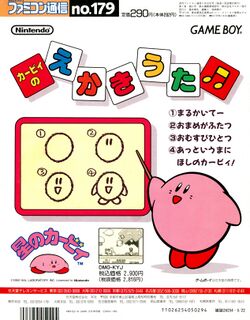
Seeking advice, HAL Laboratory went to Nintendo and in particular Shigeru Miyamoto. Seeing the appeal of the game and its character and not wanting to see such appeal wasted, Miyamoto suggested that Nintendo could publish the game after some retooling.[19] However, this new arrangement meant HAL had to cancel all purchase orders already made for the 26,000 copies of "Twinkle☆Popo".[20] The retooling came down to three fundamental changes:
- Increased ROM capacity, to two megabits.
- Extra Game, enabled by the increased memory.
- A new title, which also entailed a new name for "Popopo".
Aside from Extra Game's new enemies and damage tweaks (as well as graphic and text changes accompanying Popopo's new name), the game's content and design remained the same, and Nintendo did not require Sakurai and his team to make any further changes.[22] This included the color of "Popopo", which Miyamoto initially assumed was yellow but was pleasantly surprised to find was actually pink.[3] Miyamoto also agreed with Sakurai's overarching intention of going against the trend of increasing difficulty in games.[20]
Wanting a name that would appeal to American children, the producers asked Nintendo of America for suggestions and received a large volume of options, including "Gaspar".[3] "Kirby" was chosen from the list due to the humorous contrast between its guttural sound and the character's cutesy appearance,[23] and a significant secondary influence that Shigeru Miyamoto would acknowledge multiple times[3][24] was the role of attorney John Kirby in defending Nintendo in Universal v. Nintendo, which solidified Nintendo's foothold in America. Thus, the game gained its Japanese title, 『星のカービィ』 ("Kirby of the Stars").
Nintendo of America appear to have been significantly involved in the game's final stages of development aside from providing the name of Kirby. Many characters in the game have names derived from English words and, through the Extra Game credits (which were added in this stage), have names which are identical in English and Japanese. Specific examples include:
- Waddle Dees and Waddle Doos received their name from their duck- or penguin-like gait, with Waddle Doo in particular being named due to the round, eyeball-shaped letter "O" matching its giant eye.[4][25]
- The previously-mentioned "Gaspar" became the name of an enemy character in the Extra Game.
- Early promotional material for Twinkle Popo shows boss characters named バスターウドォ (Buster Woddo) and ダムダムブルグ (Dumdumburg), which were eventually changed to names based on English wordplay: Whispy Woods and Kaboola.[26]
Based on these examples, it is highly likely that Nintendo of America named these characters. However, they also made further name changes that did not apply to the Japanese version: for example, the setting of "Pupupuland" became "Dream Land", and the "Sweet Potato" power-up item became a "Mint Leaf". These particular changes would stick with the series' English localizations, while other, more obscure changes would not.
| Planned dates for the release of Kirby's Dream Land, advertised in Weekly Famitsu | ||
|---|---|---|
| Issue/Date | Release date | Schedule listing |
| 0168 (1992/03/06) | 21st Apr 1992 | ’92年4月発売のソフト Software for Apr '92 release 21日 〇星のカービィー<任天堂> 21st [Apr]: Kirbyy[sic] of the Stars (Nintendo) 2900円[込]/カートリッジ 2900 JPY (incl tax) / cartridge (coloured red in issue 0168, indicating first appearance) |
| 0169 (1992/03/13) | ||
| 0170 (1992/03/20) | ’92年4月発売のソフト Software for Apr '92 release 21日 〇星のカービィ<任天堂> 21st [Apr]: Kirby of the Stars (Nintendo) 2900円[込]/カートリッジ 2900 JPY (incl tax) / cartridge | |
| 0171 (1992/03/27) | ||
| 0173 (1992/04/10) | 27th Apr 1992 | ’92年4月発売のソフト Software for Apr '92 release 27日 星のカービィ<任天堂> 27th [Apr]: Kirby of the Stars (Nintendo) 2900円[込]/カートリッジ 2900 JPY (incl tax) / cartridge (coloured blue in issue 0173, indicating update as of that issue) |
| 0174 (1992/04/17) | ||
| 0175 (1992/04/24) | ||
After a minor delay from an original release date of the 21st of April, the game released in Japan on the 27th of April, 1992. It would go on to sell over five million copies worldwide, almost two hundred times the order volume for "Twinkle☆Popo".[19]
The legacy of "Popopo"[edit]
As the game had been called "Twinkle☆Popo" for most of its development, HAL Laboratory employees internally remained attached to the names used prior to Nintendo's intervention, with many staff members even calling the character "Twinkle" during the development of Kirby's Adventure.[3] In addition, callbacks to "Twinkle☆Popo" and "Popopo" appear throughout subsequent games.
- The original "Popopo of the Spring Breeze" title is referenced in the name of the Spring Breeze mode in Kirby Super Star, which is a truncated remake of Kirby's Dream Land.
- Kirby Mass Attack takes place upon the Popopo Islands, a reference to Kirby's original name.
- Two songs in Kirby Star Allies are named ティンクル☆スターズ ("Twinkle☆Stars") and ティンクル☆トラベラー ("Twinkle☆Traveler"), referencing "Twinkle☆Popo". The Japanese name for the Star Allies Sparkler, ティンクルスターアライズ ("Twinkle Star Allies"), also references this name.
- The normal staff credits theme of Kirby Star Allies is named ずっと、君を見ていると。 ("For a long time, looking at you."), which is a reference to a phrase provided by Popopo in a piece of Twinkle☆Popo advertising material: 「君を見ていると、ずっと昔からおともだちだった気がするよ。」 ("Looking at you, I feel like we've been friends for a long time.")
The pre-release state of Kirby's Dream Land as "Twinkle☆Popo" is also the subject of some fascination in certain circles.[27] Unfortunately, no dumps of any prototype ROMs of "Twinkle☆Popo" have materialized to date, although some photographs of a cartridge claiming to be a "Twinkle☆Popo" prototype have circulated on the Internet.[28]
Gallery[edit]
Concept art of Green Greens, featuring Whispy Woods with a ball and chain on his branch
Concept art of Bubbly Clowds[sic], featuring blue and pink whale-like airships resembling Kabula (who features in a more recognisable form in concept art for "Float Islands")
Concept art of "Air Fortress", featuring bean-shaped Waddle Doo-like enemies attacking from a fortress on a dark cloud
Videos[edit]
Kirby's Dream Land [Game Concepts] — Masahiro Sakurai on Creating Games
|
Development Secrets of the Original Kirby [Grab Bag] — Masahiro Sakurai on Creating Games
|
References
- ↑ 桜井政博のゲームについて思うこと Think about the Video Games (エンターブレイン), pg. 3
- ↑ 2.0 2.1 "学校と仕事とスペシャリスト(週刊ファミ通2003年12月12日号、12月19日号揭載)" –桜井政博のゲームについて思うこと Think about the Video Games (エンターブレイン), pg. 100-104
- ↑ 3.0 3.1 3.2 3.3 3.4 3.5 3.6 Kirby’s Adventure – 1993 Developer Interview (translated by Shmuplations; Wayback Machine snapshot)
- ↑ 4.0 4.1 4.2 4.3 4.4 4.5 星のカービィ 【企画コンセプト】 — 桜井政博のゲーム作るには (official English version: Kirby's Dream Land [Game Concepts] — Masahiro Sakurai on Creating Games)
- ↑ 5.0 5.1 5.2 5.3 5.4 5.5 5.6 5.7 5.8 初代『星のカービィ』開発秘話 【雑談】 — 桜井政博のゲーム作るには (official English version: Development Secrets of the Original Kirby [Grab Bag] — Masahiro Sakurai on Creating Games; also appearing in print in the 2017/05/11–18 issue of Weekly Famitsu as a special edition of Sakurai's "Think about the Video Games" column [1/2, 2/2; Wayback Machine snapshots exist of 1/2, 2/2]
- ↑ "『星のカービィというキャラクター』(週刊ファミ通2003年8月15日号揭載)" –桜井政博のゲームについて思うこと Think about the Video Games (エンターブレイン), pg. 54-56 (unofficial English translation also available from Source Gaming; Wayback Machine snapshot)
- ↑ "ちなみに、海外のカービィが白だったのは、ゲームボーイのROMが白黒だけだったため、海外の人が勘違いしたから。カービィは開発当初のイメージイラストからピンクでした。(マーカーを間違えてオレンジのものが1枚だけある) 宮本さんは、パックマンのイメージから黄色だと思っていたとか。" –Masahiro Sakurai (Twitter) (Wayback Machine snapshot).
- ↑ Satoru Iwata's appearance on the 17th Nintendo Channel special episode of Game Center CX, featuring Balloon Fight
- ↑ 9.0 9.1 20th Anniversary Kirby Pupupu Encyclopedia, page 41
- ↑ The first page of the proposal was displayed at the "Kirby Museum" promotional event in Japan, and can be viewed at this Twitter link
 (Wayback Machine snapshot).
(Wayback Machine snapshot).
- ↑ See, for example, a two-page advertisement from HAL Laboratory in issue 0148 of Weekly Famitsu, mostly focussing on a Super Famicom arcade-style joystick while spending only a fraction of the second page advertising HyperZone and Metal Slader Glory.
- ↑ Twitter link ☆よしみる (Yoshimiru Hoshi, designer of Metal Slader Glory)
 (Wayback Machine snapshot)
(Wayback Machine snapshot)
- ↑ Kirby's Dream Land - The Cutting Room Floor (Wayback Machine snapshot)
- ↑ 2017 Keyboard Magazine interview with Jun Ishikawa and Hirokazu Ando (with DeepL-based translation)
- ↑ "開発当時、サウンド担当にクリア音楽のフレーム数を聞いたところ「わからない」とのことで… カセットテープに録音したクリア音楽を何度も巻き戻しつつ、音に合わせて作りました。" –Masahiro Sakurai (Twitter) (Wayback Machine snapshot)
- ↑ Preview feature in an unknown magazine, likely dating from mid-December 1991 (Wayback Machine snapshot)
- ↑ Preview feature in a Famitsu-related or other ASCII magazine, likely dating from mid-to-late December 1991 (Wayback Machine snapshot)
- ↑ Although it is difficult to confirm the authenticity of material not published for public consumption, at least one VHS tape for in-store promotional use has surfaced for online auction, with images of the game's logo, text confirming the near-final plans for a late January 1992 release price at 3500 JPY (although issue 151 of Weekly Famitsu later showed a delayed release date of 1992/02/01, as discussed above), and a screenshot of the opening cutscene for Green Greens, except with the "Twinkle☆Popo" logo shown where the Kirby's Dream Land logo is shown in the final game's corresponding cutscene.
- ↑ 19.0 19.1 19.2 ほぼ日刊イトイ新聞 - 社長に学べ! (Wayback Machine snapshot)
- ↑ 20.0 20.1 20.2 Satoru Iwata's GDC 2011 keynote
- ↑ Shigesato Itoi's interview with Masahiro Sakurai about Satoru Iwata (Wayback Machine snapshot)
- ↑ が、実際には「ROM容量が2倍になった」「それに伴い2周目を追加できた」「タイトルを変えた」という3点だけで、ゲーム内容を変えたりゲームバランスのアドバイスをもらったわけではありません。
... but, in fact, just the three points of 'doubled ROM capacity', 'added a second game [Extra Mode] as a result', 'changed the title' ... doesn't make it the case that we changed the contents of the game or received advice about gameplay balance. —Masahiro Sakurai (Twitter link )
)
- ↑ "How did your favourite Nintendo characters get their names?" (Official Nintendo Magazine UK article)
- ↑ Miyamoto Talks Wii, Zelda And Nintendo's Past - Game Informer (Wayback Machine snapshot)
- ↑ "For starters, one of the most famous characters in the Kirby series is the cute little enemy, Waddle Dee. Obviously, it gets its name from its waddling gait." –Shinya Kumazaki (Miiverse)
The Japanese version specifically mentions that it derives from the English word "waddle": "例えば、マスコット的キャラクター、可愛いザコ敵代表の「ワドルディ」。彼の名は英語の「よちよち歩く」=waddle、が由来となっています。" –Shinya Kumazaki (Miiverse) - ↑ "Buster Woddo" and "Dumdumburg" can be seen in the Kirby's 20th Anniversary Celebration Booklet that came with Kirby's Dream Collection Special Edition.
- ↑ Prerelease:Kirby's Dream Land - The Cutting Room Floor (Wayback Machine snapshot)
- ↑ Twitter link
 (Wayback Machine snapshot); additional photo (Wayback Machine snapshot)
(Wayback Machine snapshot); additional photo (Wayback Machine snapshot)
| |||||||||||||||||||||||
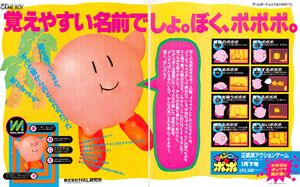
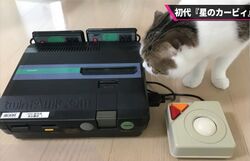

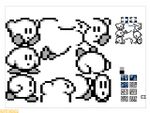

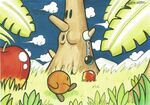

![Concept art of Bubbly Clowds[sic], featuring blue and pink whale-like airships resembling Kabula (who features in a more recognisable form in concept art for "Float Islands")](https://cdn.wikirby.com/thumb/d/d6/Bubbly_Clowds_-_Twinkle_Popopo.jpg/150px-Bubbly_Clowds_-_Twinkle_Popopo.jpg)
